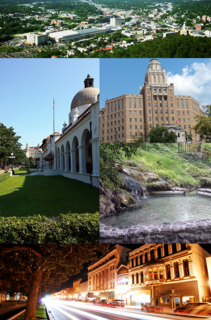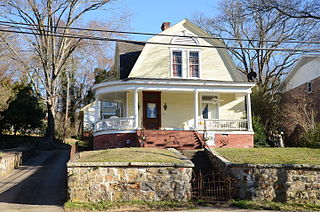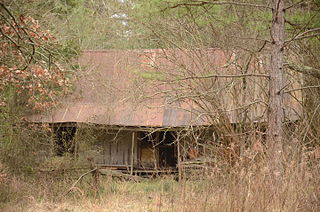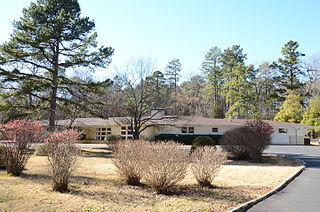
Hot Springs is a resort city in the state of Arkansas and the county seat of Garland County. The city is located in the Ouachita Mountains among the U.S. Interior Highlands, and is set among several natural hot springs for which the city is named. As of the 2020 United States Census, the city had a population of 37,930.

The Lewis House, also known as Lewis Spring House, is a historic home in Tallahassee, Florida, located north of I-10, at 3117 Okeeheepkee Road. It was built in 1954. On February 14, 1979, it was added to the U.S. National Register of Historic Places. It was designed by Frank Lloyd Wright for George Lewis II, President of the Lewis State Bank, and his wife Clifton. George Lewis gave the name "Spring House" to the home "for the natural spring and small stream that flows from the property." The National Trust for Historic Preservation describes its significance: "The novel hemicycle form of Spring House represents a late, and little-known, stage in Wright’s long, prolific career. Although there are approximately 400 intact houses attributed to Wright throughout the country, only a fraction were from his hemicycle series."

The Arlington Resort Hotel & Spa is a resort in the Ouachita Mountains of Hot Springs National Park, Arkansas, home of Oaklawn Race Track and the Arkansas Derby. The Arlington's design inspired the Baker Hotel in Mineral Wells, Texas. The hotel is located at the north end of "Bathhouse Row".

Bathhouse Row is a collection of bathhouses, associated buildings, and gardens located at Hot Springs National Park in the city of Hot Springs, Arkansas. The bathhouses were included in 1832 when the Federal Government took over four parcels of land to preserve 47 natural hot springs, their mineral waters which lack the sulphur odor of most hot springs, and their area of origin on the lower slopes of Hot Springs Mountain.

The Wynne House is a historic house on 4th Street in Fordyce, Arkansas. The two story wood-frame house was built in 1914, and is the city's best example of residential Classical Revival architecture. It is Foursquare in plan, with a hip roof with large gable dormers projecting. A porch wraps around two sides, featuring elaborate spindled balusters and Ionic columns.

Couchwood is the summer estate of Harvey C. Couch, an industrialist and founder of Arkansas Light and Power in the early 20th century. The estate, located at 601 Couchwood Road, is southeast of Hot Springs, Arkansas, straddling the border of Garland and Hot Spring counties on the north shore of Lake Catherine.

George Richard Mann was an American architect, trained at MIT, whose designs included the Arkansas State Capitol. He was the leading architect in Arkansas from 1900 until 1930, and his designs were among the finalists in competitions for the capitols of several other states.

Charles L. Thompson and associates is an architectural group that was established in Arkansas since the late 1800s. It is now known as Cromwell Architects Engineers, Inc.. This article is about Thompson and associates' work as part of one architectural group, and its predecessor and descendant firms, including under names Charles L. Thompson,Thompson & Harding,Sanders & Ginocchio, and Thompson, Sanders and Ginocchio.

The Fordyce House is a historic house at 746 Park Avenue in Hot Springs, Arkansas. It is a 1+1⁄2-story wood-frame structure, with a hip roof that has large cross-gabled gambrel dormers projecting in each direction. It has a curved wraparound porch supported by Tuscan columns. It was built in 1910 to a design by architect Charles L. Thompson, and is an excellent local example of Colonial Revival architecture.

Frank W. Gibb was an architect in Little Rock, Arkansas.

Earl T. Ricks was a senior officer of the United States Air National Guard who served as deputy chief of the National Guard Bureau, chief of the Air Force Division, National Guard Bureau (1950–1954), and acting chief of the National Guard Bureau. His four months as acting bureau chief made him the first Air National Guard officer to hold the position.

John Parks Almand was an American architect who practiced in Arkansas from 1912 to 1962. Among other works, he designed the Art Deco Hot Springs Medical Arts Building, which was the tallest building in Arkansas from 1930 to 1958. Several of his works, including the Medical Arts Building and Little Rock Central High School, are listed on the National Register of Historic Places.

The Charlotte Street Historic District encompasses a historic residential subdivision in Fordyce, Arkansas. The district extends along Charlotte Street between Holmes and East 4th Streets, and includes a few properties on Broadway, as well as the remaining grounds of the estate of A. B. Banks, an insurance company owner who oversaw the area's development in the 1920s. The area originally consisted of a large tract of land outside the city, which was annexed to it in 1906. Charlotte Street was named for Banks' wife, and he had a handsome estate house built on this land which was designed by Charles L. Thompson, which burned in 1964. Many features of the estate, located between Broadway and East 4th, have been retained, including an inground swimming pool that was supposedly the first private pool in the state.

The Fordyce Commercial Historic District encompasses the historic heart of Fordyce, Arkansas, the county seat of Dallas County. It encompasses four city blocks of North Main Street, between 1st and 4th, and includes properties on these adjacent streets. Fordyce was founded in 1882, and the oldest building in the district, the Nutt-Trussell Building at 202 North Main Street, was built c. 1884. Spurred by the logging industry and the Cotton Belt Railroad, Fordyce's downtown area had 25 buildings by 1901, and continued to grow over the next few decades, resulting in a concentration of period commercial architecture in its downtown. The district was listed on the National Register of Historic Places in 2008.

The Nutt–Trussell Building is a historic commercial building at 202 North Main Street in downtown Fordyce, Arkansas, USA. Built in 1883, this two-story structure was the first brick building erected in Fordyce, a railroad town in southwestern Arkansas. Its exterior was covered in stucco c. 1920. It was built by Robert Nutt, who operated a dry goods shop on the premises. It later housed the Bank of Fordyce, and its upper floor has a long history of use for social club meetings, and also housed the city's first telephone exchange. The descendants of L. L. Trussell, a later owner, gave the building to the city in 2000 for use as a local history museum.

The John Russell House is a historic house at 904 Charlotte Street in Fordyce, Arkansas. This single-story wood-frame house was built c. 1925, and is Dallas County's finest example of Craftsman architecture. It has an outstanding porch whose roof is supported by four columns of geometrically arranged wooden members. A horizontal tie beam between the inner columns supports a column up to the apex of the gable roof.

The Dr. Boaz House is a historic house in rural western Clark County, Arkansas. It is located on the south side of Arkansas Highway 26, just west of its junction with County Road 291, near the hamlet of Clear Spring. The dog trot house was probably built c. 1891 by Samuel Peeples as a wedding present for his daughter Annie and Doctor A. Boaz. The house is entirely vernacular in style, and is sheathed primarily in board-and-batten siding. The northern (front) facade has a porch extending its full width, with a chimney on the exterior of the western wall. A kitchen ell extends to the rear (southward) of the western portion of the main block. The house is the finest known instance of the vernacular dog trot form in Clark County.

The Fordyce–Ricks House Historic District encompasses a locally rare collection of Adirondack Architecture structures located at 1501 Park Avenue in Hot Springs, Arkansas. The district encompasses 37 acres (15 ha) of land that originally belonged to Samuel W. Fordyce, a prominent railroad executive who had a major role in promoting and developing Hot Springs as a resort community. The district includes a 1+1⁄2-story octagonal log house, three outbuildings, and a landscaped rustic environment. 20 acres (8.1 ha) of the former estate are now a part of Hot Springs National Park.

The Peter Dierks Joers House is a historic house at 2111 Park Avenue in Hot Springs, Arkansas. Built in 1955, this single story wood and limestone structure is one of the finest local examples of Mid-Century Modern / Ranch architecture. The house is basically U-shaped, with a central public living area, a bedroom wing, and a service wing. Windows are typically full length in height, and most of the exterior is clad in irregularly-laid limestone, with some weatherboard siding. The house was built for Peter Dierks Joers, heir to the locally prominent Dierks Lumber Company, whose sale to Weyerhaeuser he oversaw. The house interior is a showcase of Arkansas wood types and woodwork.

The Woodmen of Union Building is a historic commercial building at 501 Malvern Avenue in Hot Springs, Arkansas. It is a four-story structure, built mainly out of brick and ceramic blocks, although its southeastern section has upper levels with wood framing and finishing. Its main facade has an elaborate projecting entrance portico, with the entrance set in an elliptical-arch opening supported by fluted pilasters. The interior retains significant original features, including a bank vault, marble wainscoting, and a 2,500-seat auditorium. It was built in 1923-24 for the Supreme Lodge of the Woodmen of Union, an African-American social organization, which operated it as a multifunction bathhouse, hotel, hospital, bank, and performance venue. It was purchased in 1950 by the National Baptist Association.






















